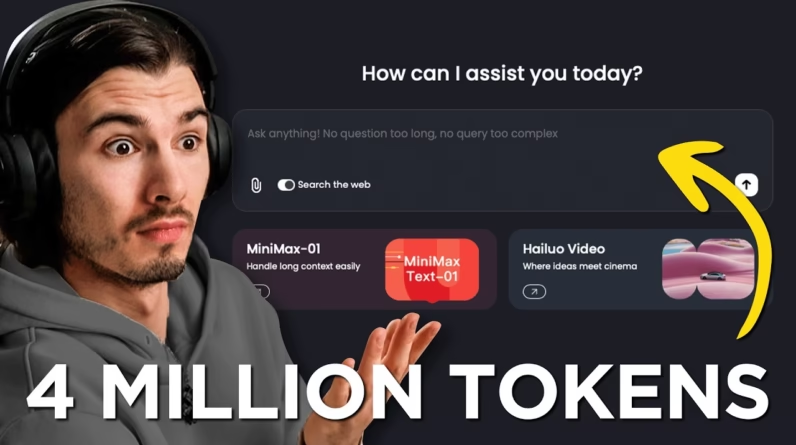
no-code platforms are reshaping how non-developers approach app creation, unlocking new opportunities to build custom solutions without the need for complex coding skills. This article explores the concept of no-code platforms, focusing on a hands-on example of building a knowledge-based chatbot using LlamaIndex. You’ll learn about loading specific data sources to create chatbots tailored for various applications, like customer service, and understand the benefits of integrating custom knowledge into existing language models.
Get ready to discover the power of no-code technology through an engaging video tutorial that demonstrates creating a ChatGPT-style chatbot in just minutes. Key features include incorporating data from various sources and customizing outputs to meet specific needs. By the end, you’ll be equipped with the tools to replicate this process for your own projects, enhancing your ability to create impactful applications tailored to your requirements.
Table of Contents
What are No-Code Platforms?

Definition and Overview
No-code platforms are tools that allow users to create applications without needing to write traditional programming code. Instead, you can use visual interfaces and pre-built components to build your applications. These platforms use a combination of graphical user interfaces (GUIs), logic flows, and sometimes templates, enabling users from various backgrounds—whether business, marketing, or design—to engage in software development. This democratization of software creation empowers you to bring your ideas to life quickly and efficiently without relying heavily on technical expertise.
History and Evolution
The no-code movement has its roots in the 1990s with the advent of visual development environments that allowed users to design applications through drag-and-drop interfaces. Over the years, as computing power increased and the internet became more ubiquitous, these platforms evolved significantly. By the 2010s, a slew of no-code platforms emerged, catering to different aspects of development—from website creation to complex enterprise applications. Today, with advancements in cloud technology and improved user experiences, no-code platforms are more sophisticated than ever, enabling not just prototype creation but the development of fully functional applications.
Goals of No-Code Development
No-code development aims to empower a broader audience to participate in the software creation process. The primary goals include simplifying the development process, reducing the reliance on professional developers, and accelerating the time-to-market for various projects. Ultimately, these platforms strive to unlock creativity and innovation by making it possible for anyone with an idea to build functional applications with minimal barrier to entry.
Benefits of No-Code Platforms
Empowering Non-Developers
One of the standout advantages of no-code platforms is their accessibility for individuals without programming backgrounds. Imagine you want to launch a new app or website but don’t know how to code; with no-code tools, you can! This empowerment allows you to take control of your projects, encouraging creativity and facilitating experimentation. You can build and iterate on your ideas without waiting for technical teams, giving you the freedom to explore your vision.
Accelerating Development Speed
No-code platforms significantly expedite the development process. Instead of taking weeks or months to create and deploy an application, you can often accomplish this in a matter of days or even hours. The use of templates, pre-built components, and visual interfaces means you spend less time on technical details and more time refining your idea or solution. This speed is especially beneficial in today’s fast-paced business environment, where time-to-market can determine success or failure.
Cost-Effectiveness
Utilizing no-code platforms can also be a cost-effective solution for startups and small businesses. Traditional development often requires a significant investment in hiring skilled developers or outsourcing projects. With no-code tools, you can reduce these costs substantially, as you do not require extensive technical knowledge or the resources typically associated with traditional development. This opens up opportunities for businesses to allocate funds to other critical areas such as marketing, sales, or product iteration.
Key Features of No-Code Platforms
User-Friendly Interfaces
No-code platforms are designed with user experience in mind. They typically feature intuitive, user-friendly interfaces that guide you through the development process. These platforms often provide drag-and-drop tools that make it easy to design layouts, add components, and create workflows without needing technical coding skills. This emphasis on usability means that you can focus on your ideas and solutions rather than getting bogged down with technical hurdles.
Drag-and-Drop Functionality
A hallmark of no-code platforms is their drag-and-drop functionality. This feature allows you to easily move elements around the interface to create the desired application layout. Whether you’re customizing a website or setting up a complex process flow, the drag-and-drop approach streamlines the development process, making it accessible to everyone, regardless of their technical ability.
Integration with Third-Party Services
No-code platforms often come with built-in capabilities to integrate with various third-party services and APIs. This means you can connect your application to popular tools like payment processors, social media platforms, and databases with minimal effort. These integrations expand the functionality of your applications, making it easier than ever to add features that enhance user experience and streamline operations.
Popular No-Code Platforms of 2024
Overview of Webflow
Webflow is a no-code platform designed primarily for web design and development. It allows you to visually create responsive websites without writing any code. With its powerful CMS and e-commerce features, Webflow is an excellent choice for businesses and individuals looking to build stunning websites that are easy to manage. Its intuitive interface and extensive library of templates enable you to get started quickly while still having the flexibility to customize your designs.
Exploring Bubble
Bubble is a no-code platform focused on building web applications. It enables you to create highly interactive, database-driven applications without coding. With Bubble, you can design your app with its visual editor, define workflows, and manage a robust database—all from one place. This makes it a great choice for entrepreneurs and startups who want to validate their ideas rapidly.
Introduction to Adalo
Adalo is a no-code platform aimed at mobile application development. Offering a straightforward way to build iOS and Android apps, Adalo allows you to create applications using pre-made components and templates. Its focus on mobile experience means you can design, prototype, and launch your mobile app without needing extensive coding knowledge, appealing to non-developers eager to tap into the mobile market.
Understanding Glide
Glide is a no-code platform that specializes in turning Google Sheets into fully functional mobile applications. By syncing your data with a Google Sheet, Glide allows you to create user-friendly apps quickly and easily. This platform is especially useful for those who want to prototype ideas rapidly or build applications that require content management without complex coding.
Comparing No-Code Platforms
Feature Comparison
When considering various no-code platforms, it’s essential to compare their features. For instance, Webflow excels in web design with unparalleled customization options, while Bubble offers comprehensive app-building capabilities. Adalo shines in mobile app development, and Glide is perfect for those who want to leverage data from Google Sheets. Depending on your project’s requirements, certain platforms may serve your needs better than others.
Pricing Structures
No-code platforms have various pricing structures, often based on features, user limits, or the number of projects you can manage. By choosing a platform that aligns with your budget, you can maximize your investment while still getting the functionalities you need. While some platforms offer free tiers with limited features, premium plans can provide extensive capabilities suitable for growing businesses.
Targeted User Types
Different no-code platforms are tailored for specific user types. For example, Webflow is ideal for designers and marketers, while Bubble is focused on entrepreneurs looking to develop complex applications. Adalo caters to those wanting to enter the mobile app market, while Glide appeals to users who prefer working with data directly from Google Sheets. Understanding your user type will help you choose the best platform for your needs.
Choosing the Right No-Code Platform
Assessing Project Requirements
Before selecting a no-code platform, you should assess your project requirements carefully. Consider the type of application you want to build, any specific functionalities you need, and the audience it aims to serve. By understanding these aspects, you can select a platform that meets your needs without overwhelming you with unnecessary features.
Considering Budget Constraints
Your budget plays a significant role in determining which no-code platform to choose. Different platforms offer varied pricing models, and understanding your financial limits will help you narrow down your options. Keep in mind the long-term costs associated with scaling your app and any additional features you may require as your project evolves.
Evaluating Ease of Use
Lastly, ease of use should be a top consideration when selecting a no-code platform. Many platforms provide free trials or demos, allowing you to test their interfaces before committing. You want a platform that feels intuitive and comfortable to navigate, enabling you to focus on building rather than spending valuable time learning complex tools.
No-Code Development Use Cases
Building Mobile Apps
No-code platforms like Adalo and Glide enable you to create mobile applications without extensive coding knowledge. Whether you aim to develop a social app, a customer service chatbot, or an e-commerce solution, no-code tools simplify the entire process, making it accessible for anyone interested in mobile app development.
Creating Interactive Websites
With platforms like Webflow, you can build interactive and visually stunning websites that capture your audience’s attention. No-code tools allow you to incorporate dynamic elements, animations, and even e-commerce functionalities without needing a technical background. This flexibility enables you to create captivating online experiences effectively.
Automating Business Workflows
No-code platforms can also help automate various business workflows. Tools like Zapier and Airtable allow you to connect multiple applications, creating seamless processes that save time and reduce the chance for human error. By automating repetitive tasks, you can focus on higher-level strategies and decision-making.
Common Challenges in No-Code Development
Understanding Platform Limitations
Although no-code platforms offer a wealth of functionality, it’s essential to understand their limitations. Not every application can be built solely with no-code tools; some projects may require custom coding. Familiarizing yourself with what a platform can and cannot do will help set realistic expectations for your project.
Handling Scalability Issues
While no-code platforms streamline initial development, scaling your application can present challenges. Platforms may have performance limitations as user numbers grow, or the complexity of your application may exceed what is manageable without code. Always consider your long-term growth strategy and ensure the chosen platform can adapt accordingly.
Addressing Security Concerns
Security is a crucial aspect of any application, and with no-code platforms, you must remain vigilant. Some platforms may have inherent security vulnerabilities, especially if they rely on integrations with other services. Ensure you understand the security measures offered and take steps to enhance your application’s security as necessary.
Future Trends in No-Code Development
Advancements in AI and Automation
As technology progresses, the integration of artificial intelligence (AI) into no-code platforms is becoming increasingly prevalent. Future developments may include smarter suggestions based on user actions and enhanced capabilities for automating complex processes. This trend will allow you to create more sophisticated applications without needing advanced technical skills.
Growth of Community and Support Networks
The no-code movement is building a strong community of users and developers. This growth leads to a wealth of resources, such as forums, tutorials, and webinars that support your journey. Engaging with these networks can provide valuable insights, tips, and shared successes that may inspire you as you embark on your no-code development projects.
Increased Customization Options
In the future, expect no-code platforms to offer even more customization capabilities. As user demands grow, platforms may incorporate features that allow tailored workflows, appearances, and integrations that meet specific requirements. This increased flexibility will further enhance your ability to create applications that resonate with your intended audience.
Conclusion
Summary of Key Points
In summary, no-code platforms are revolutionizing the way applications are built, making development accessible to everyone. With benefits like faster development, lower costs, and the empowerment of non-developers, these tools are changing the landscape of software creation. Understanding key features and selecting the right platform can set you on a path toward success.
The Importance of No-Code in the Modern Development Landscape
No-code development addresses the rising demand for innovative applications while reducing barriers to entry for aspiring creators. As more people turn to technology for solutions, empowering a wide audience to build and iterate on their ideas is essential. No-code platforms are pivotal in this evolution, enabling a diverse range of new tools and applications.
Encouragement for Non-Developers to Explore No-Code Tools
If you’re not a developer, don’t let that discourage you! The world of no-code is vibrant and inviting, offering you the chance to turn your ideas into reality. Explore various platforms, experiment with their features, and see what you can create. Your unique perspective can lead to innovative applications, and the possibilities are endless with no-code development.







